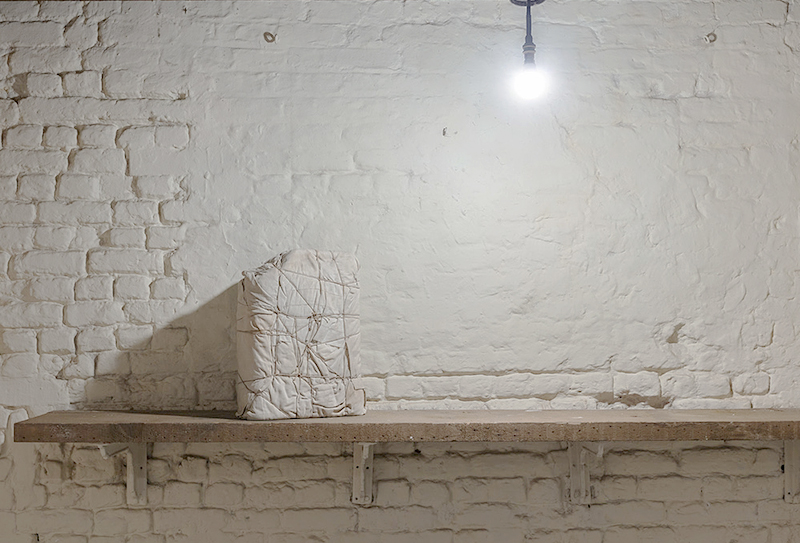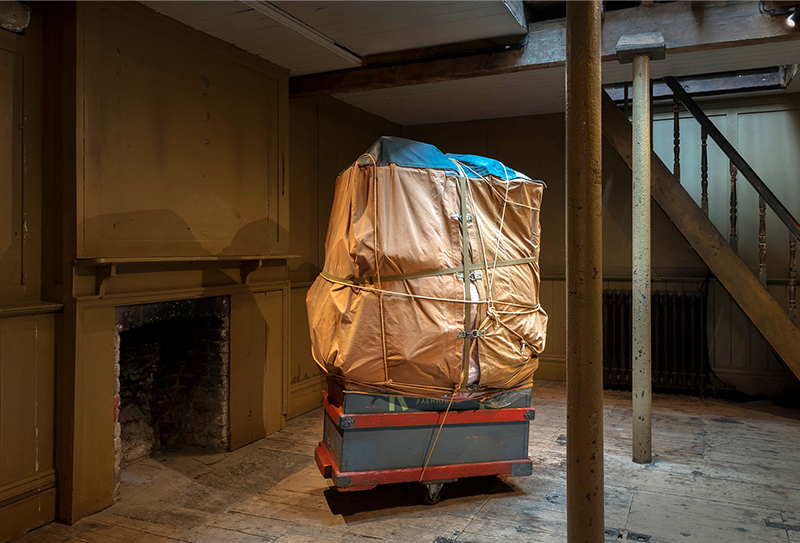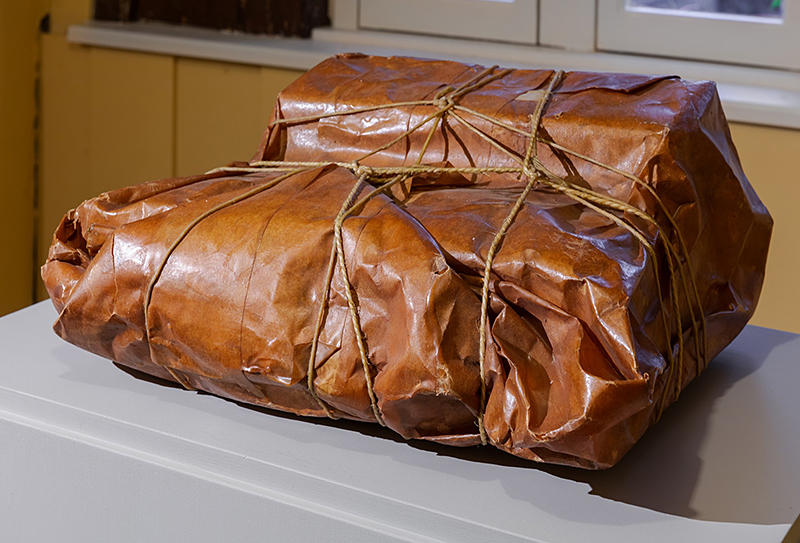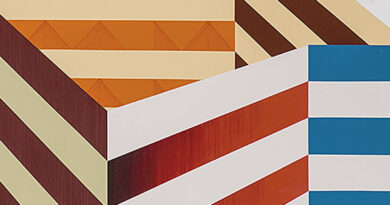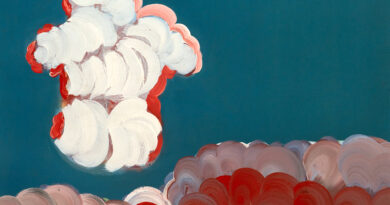christo: early works *
MÜMTAZ SAĞLAM
Christo: Early Works, through a presentation that reconciles the privileged space, takes the possibilities of a communication through political and historical connections and shocking psychological effects and reinforces its existing visual effects. Elena Guena’s project and presentation, which goes beyond the image of Christo and reveals the context of personal history, time, object and space of a period, becomes an important attempt to re-evaluate and make sense of a content determined by historical, political or social conditions.
4– Wrapped Magazines, 1972-73, Magazines, polyethylene, rope, and twine, Overall dimensions variable. (All Artwork: Christo and Jeanne-Claude Foundation), [https://christojeanneclaude.net] (Photos by Lucy Dawkins), [https://gagosian.com/exhibitions/2023/christo-early-works-curated-by-elena-geuna]
Christo: Early Works, held in London between 6-22 October 2023, attracted great attention. A selection of the artist’s early works was presented in a temporary space created for this event under the name Gagosian Open.[1] Christo’s early works, realised during the Paris process, reflect the first examples of an aesthetic conception in which some of the objects he appropriated were packaged for protection due to concerns related to the reality of displacement. There is no doubt that this exhibition is very important as it shows the precursors of an experimental and extremely new artistic practice.
These works are also memorial symbols of the dramatic reality of migration, emphasising the artist’s migrant identity. Christo clearly subverts the perceptual habits of the period and endeavours to embrace everyday objects, to protect them by depriving them of their functions or concealing them… Indeed, it is obvious that an act of protection or concealment gains political dimensions and meanings due to the conditions of the period in which it is produced. Therefore, while Christo documents a testimony that leaves a trace in his personal history with his object arrangements and simple packaging practice, he also reveals the intellectual dynamics of a radical and innovative attitude that is open to development.
object arrangements in the context of reconciliation with space
Meanwhile, it is necessary to mention the location of this effective presentation, which brings the works in question into a conceptual context and makes them visible. This double-fronted, narrow and three-storey immigrant house, located in Spitalfields in East London and built in the 18th century, is a special place that supports an extraordinary viewing experience with its story and existing texture.[2] In addition, it is clear that the common feeling created by the fact that the settlement where this building is located was a region where Eastern European and Asian immigrants lived until recently, combined with the tragic meanings created by the phenomenon of immigration and refugee, and adds a different dimension to the exhibition. Moreover, this space also has an atmospheric effect that enriches the visuality of the object arrangements on display. Already, Christo’s spatial context, which reconciles with object arrangements, together with Elena Geuna’s curatorial justifications, highlights an aesthetic that hybridizes the visual field. By preventing the sculptural solitude of the objects here, it enables them to gain a brand new visibility with space references to the wrapping practice it represents. Thus, the entire spatial arrangement, which becomes more intense (immersive), is dragged into another dimension and meets with cultural, ethnic and personal meanings that exceed the usage function of the object covered, covered or connected.
Therefore, the Early Works selection, through a presentation that reconciles the privileged space, takes the possibilities of a communication through political and historical connections and shocking psychological effects behind it and reinforces its existing visual effects. Elena Guena’s project and presentation, which goes beyond Christo’s imagination and reveals the context of personal history, time, object and space of a period, becomes an important attempt to re-evaluate and make sense of a content determined by historical, political or social conditions.
It is evident that Christo’s initial choice of objects and the domestic nature of his actions and the emphasis on his migrant identity have lost their impact over time and have been replaced by an approach that relies on a conceptual character. For this reason, it should be remembered here that Christo and Jeanne-Claude have been hesitant to present personal and dramatic content, and have come up with public projects and large-scale space arrangements.[3] It is indeed an extraordinary experience to see and make sense of this series of small, effective and dramatic works, which are almost the harbingers of the large-scale projects that Christo and Jeanne-Claude will realise in the following years, by pulling them into a new spatial context within the concept of Gagosian Open, and to see and make sense of them again in the axis of migration and trauma discussions. Approaching the issue of displacement, relocation or migration from the point of view of the refugee spirit, this visuality or this seemingly strange narrative; in fact, it reflects the traces of a burning reality.
Christo’s early works, epitomising the instinct or imperative to preserve and protect, become a series of iconic signifiers that clarify the distinction and significance of the private and preserve and integrate their stories.
Mümtaz Sağlam, Copyright © 2023 / All Rights Reserved.
* Christo: Early Works, (Küratör: Elena Geuna), 6-22 Ekim 2023, Gagosian Open, 4 Princelet Street, London.
Also see: https://saglamart.com/christo-paketlenmis-bir-hafiza-monologu
NOTES
[1] Gagosian Open is a new project developed by Gagosian to create an alternative exhibition opportunity. Christo: Early Works is the first production in this series of independent, ambitious, temporary and specialised spaces that prioritise the viewer experience with an unconventional approach.
[2] House number 4 on Princelet Street is a terraced, double-fronted, three-storey building. It has survived to the present day with its character intact, thanks to the strength of its yellow brick and wood construction materials and techniques. The building was registered as a second degree protected site in 1969 and its historical value was determined. See also: Christo, Early Works, (Press Release and Exhibition Brochure), Gagosian Open, 4 Princelet Street, October, 6-22, 2023, London.
[3] Christo’s adventure in packaging or covering things, which begins with empty metal cans and glass bottles, becomes obsessive to the point of object fetishism. Due to the strange aesthetics it creates and the differences in meaning that create a richness of associations, this practice, which changes in size, scope and quality in a short time, does not delay in turning into a different formalisation event. In 1964, soon after their move to New York, Christo and Jeanne-Claude’s art became synonymous with large environmental projects. (For more information, see: Matthias Koddenberg, “Christo’s Drawings from Vision to Document”, Christo and Jeanne-Claude: Projects 1963-2020, Palais Populaire, Berlin, 2021.

